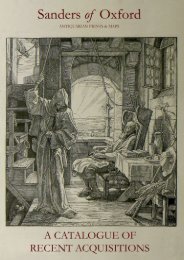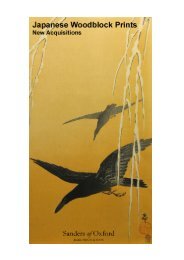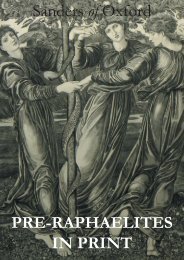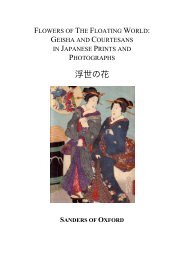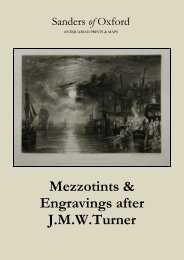«Heading» - International League of Antiquarian Booksellers
«Heading» - International League of Antiquarian Booksellers
«Heading» - International League of Antiquarian Booksellers
You also want an ePaper? Increase the reach of your titles
YUMPU automatically turns print PDFs into web optimized ePapers that Google loves.
common and scientific names <strong>of</strong> many species, it is the<br />
quality <strong>of</strong> his illustrations that he is best remembered<br />
for.<br />
Thomas Hodgetts (fl.1801-1846) was a London-based<br />
painter and mezzotint engraver. He specialised in<br />
religious subjects, portraits and landscapes. Hodgetts<br />
exhibited regularly at the Royal Academy between 1801<br />
and 1824. He also showed his work at the British<br />
Institution and, as an engraver, at the Suffolk Street<br />
gallery from 1778 to 1783.<br />
His friend William Elford Leach, head <strong>of</strong> zoology at the<br />
British Museum encouraged him to experiment with<br />
lithography for his book Zoological Illustrations (1820-<br />
23). Swainson became the first illustrator and naturalist<br />
to use lithography, which was a relatively cheap means<br />
<strong>of</strong> production and did not require an engraver. He began<br />
publishing many illustrated works, mostly serially.<br />
Subscribers received and paid for small sections <strong>of</strong> the<br />
books as they came out so that the cash flow was<br />
constant and could be reinvested in the preparation <strong>of</strong><br />
subsequent parts. As book orders arrived, the<br />
monochrome lithography prints were hand-colored,<br />
according to color reference images, known as 'pattern<br />
plates', which were produced by Swainson himself. It<br />
was his early adoption <strong>of</strong> this new technology and his<br />
natural skill <strong>of</strong> illustration that in large part led to his<br />
fame. These plates are from the edition published<br />
between 1820-1821.<br />
George Morland (1763-1804) was a painter <strong>of</strong><br />
landscapes and sentimental rustic scenes. Son <strong>of</strong> the<br />
painter, Henry Robert Morland, to whom he was<br />
apprenticed in 1777, George Morland was precocious,<br />
gifted and dissolute, spending much <strong>of</strong> his later career<br />
facing a debtor's prison, despite the popularity <strong>of</strong> his<br />
work.<br />
Lennox-Boyd i/i<br />
Ex. Col.: Hon. Christopher Lennox-Boyd<br />
Condition: Overall toning to sheet. Large repaired tear<br />
to the lower margin running through the title and<br />
publication line and just affecting image. Laid to<br />
backing sheet.<br />
[27572]<br />
£280<br />
109. Puss<br />
Mezzotint with etching and drypoint printed in colours<br />
Thomas Hodgetts after George Morland<br />
London Published April 11 1810 by H. Morland Dean<br />
Street Soho<br />
Image 299 x 373, Plate 327 x 378 mm, Sheet 410 x 484<br />
mm<br />
unmounted<br />
Unusual colour printed, mixed method engraving <strong>of</strong> a<br />
cat infront <strong>of</strong> a bowl <strong>of</strong> milk.<br />
110. [Rabbits]




